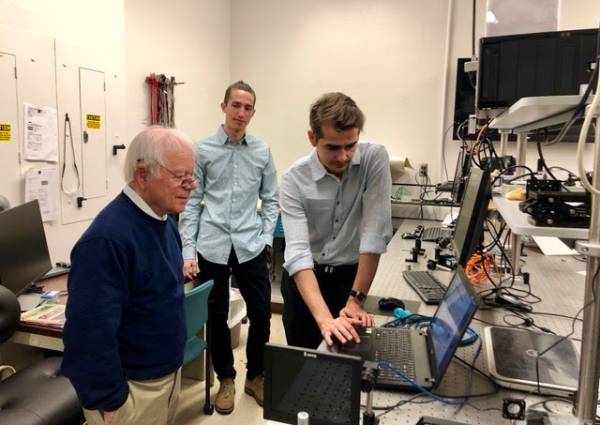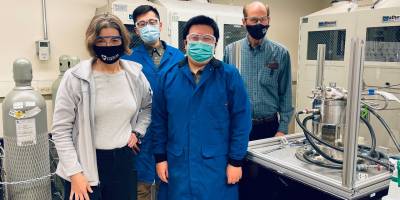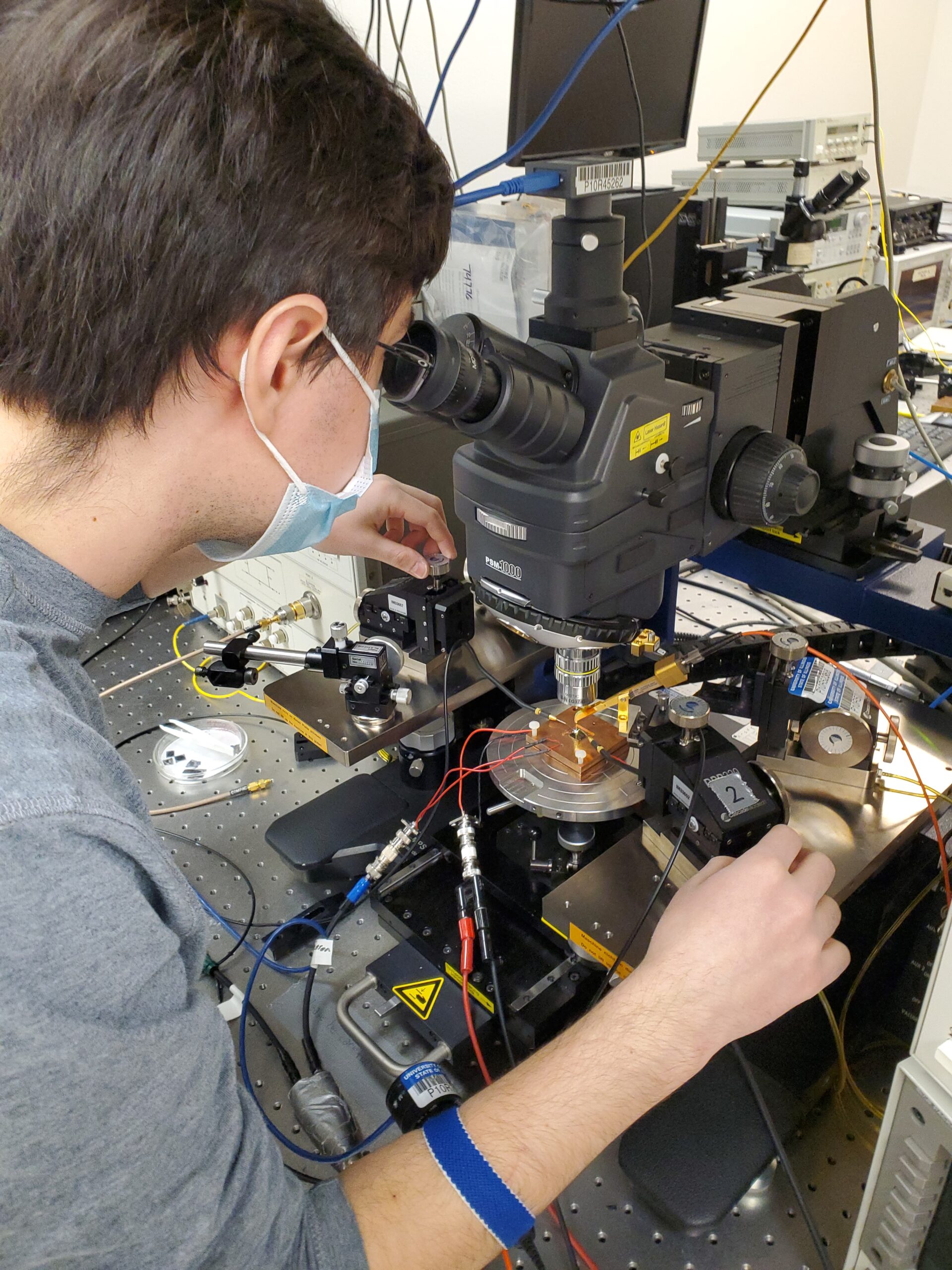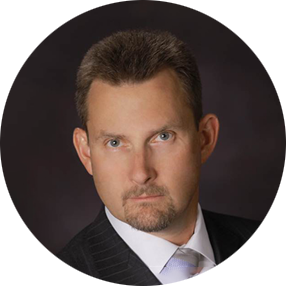Block-Gift Program

Promoting Research and Educating Students at the Graduate Level
The Coherent / II-VI Foundation is focused on educating the next generation of engineers, scientists and mathematicians. All Block-Gift programs must have the students and student education as its primary focus.
Block-Gift research topics typically fall into one of three major Technology Focus Areas: Optics, Lasers & Photonics, Additive Manufacturing and Wide Bandgap Power Electronics. Periodically we augment these areas with topics of special interest. Currently chip level photonics integration, quantum communications, and solid state batteries are of interest. In general, Block-Gift projects tend to emphasize research involving material synthesis, crystal growth and processing, and novel device studies including design, fabrication, and characterization.
Block-Gift programs must have the following attributes:
Please note: Proposals are accepted on an invitation-only basis. Please see the “Block-Gift Consideration Procedure" page for guidelines. If you would like further information on the invitation process, please write to: admin@co26fdn.org.

Block-Gift Procedure
Learn how to participate

Block-Gift Consideration Procedure
THIS PROCEDURE MUST BE FOLLOWED TO BE CONSIDERED FOR A BLOCK-GIFT INVITATION …
Key Dates
The following 2023-2024 critical dates and report fillings must be met:
July 1st — First day of the Block-Gift cycle
Initial funding of one-half of the total Block-Gift
All documentation must be signed and returned prior to this initial disbursement (funding).
November 1st — Progress Report is due
At the II-VI Foundation, we believe that communication skills – both verbal and written – are an important part of the student development process and a key professional skill. We encourage the students, with their advisors’ counsel, to prepare the required Block-Gift program progress reports to practice these skills. ONE report should be filed for each Block-Gift program. Students should collaborate to produce ONE report.
This brief, EIGHT PAGE MAXIMUM, student composed technical report should describe progress to date and include:
-
Short and Concise Summary
*Begin the report by reviewing the project goal, citing important results that were accomplished in the project period to date, and outlining future activity for the next period with a simplified schedule.
-
Results
*A description of key results supported by illustrations and a discussion of the significance of the experimental or theoretical findings.
-
Conclusions
*A description of conclusions drawn from the research results and the importance thereof.
-
Future or Planned Work
*Identify the technical challenges to be addressed going forward.
-
Current education/degree status of all students working on this project
-
Presentations, Degrees Granted, Conferences Attended, Publications,
*List any presentations made about the research results, degrees granted to students involved in the research, conferences attended and articles published about the research. Please include copies of articles whenever possible.
First Week of December
Invitation letters are sent informing institutions of the opportunity to submit a White Paper Proposal/Application for the next Block-Gift cycle.
First Week of January
Second funding of the cycle, disbursing the second half of the Block-Gift
February 15th — APPLICATION date and RENEWAL APPLICATION date
Any institution seeking initial or follow-on funding for the next cycle must apply using the appropriate application form found at the Foundation’s website (www.co26fdn.org). The applications change annually. Please make certain you have the one with current Due Dates. This will act as a second update on the research topic for renewal requests.
II-VI Foundation is focused on educating the next generation of engineers, scientists and mathematicians. Generally, we do not allocate resources to post-doc efforts but when we do their compensation falls within the “professor’s salary” section of the budget as they are no longer students. All Block-Gift programs must have students and student education as its primary focus.
March – April — Informed of the Selection Committee’s decision
Those institutions who applied on February 17th will be informed of the Selection Committee’s decision. Assuming a favorable decision, a follow-on visit may be scheduled and new documentation must be signed.
Upon notification of funding, institutions must supply the II-VI Foundation Office with the following information:
-
Person signing the gift documentation (Memorandum of Understanding) and their title
-
Address where the Memorandum of Understanding should be sent
-
Check payee
-
Address where checks should be mailed
April – May — Sign and Return
Upon receipt of the Memorandum of Understanding, both copies should be signed with one copy returned to the II-VI Foundation.
June 30th — Last day of the Block-Gift Cycle
Last Day of the Block-Gift Cycle
July 15th — Final Progress Report of the cycle which ended June 30th
This should be prepared by the student and be concise totaling only two pages with no figures. It should include:
-
Key progress highlights
-
Brief description of any outstanding issues
-
A list of articles published, presentations made, degrees granted and conferences attended.
August 31st — A Budget Reconciliation is due
Use the II-VI Foundation Budget Proposal and Reconciliation Form that you submitted with your initial proposal. Complete the orange sections. This would compare the initial proposal budget against how the funds were actually spent. It is required prior to the second disbursement for the next Block-Gift cycle.
September 1st — For NEW Block-Gift Topics
For NEW Block-Gift Topics you must submit a one-page Research Concept Summary by this date.
We encourage electronic submissions. Please submit all proposals, reports and reconciliations to: Coherent/II-VI Foundation, Attn: Block-Gift Program, admin@co26fdn.org
Meet Coherent/ II-VI Foundation Block-Gift Technical Team
Thomas E. Anderson, PhD | Associate Executive Director
Dr. Thomas Anderson possesses more than 40 years of technical management and business leadership experience. He spent 19 years at Litton-Airtron, Morris Plains, New Jersey as a member of the technical management team. At Litton-Airtron, he started the GaAs substrate electronic materials business as a member of the technical staff and helped grow it to a world leadership position and developed the world’s first 6-inch GaAs wafers. He continued a 19-year career at Airtron as a division General Manager and prior to the acquisition by Northrop-Grumman was promoted to Vice President of Research and Development and CTO.
In 2001, II-VI Incorporated purchased the Silicon Carbide substrate technology from Northrop-Grumman and hired Dr. Anderson as General Manager of the newly acquired Silicon Carbide business, a Division of II-VI Incorporated. The Silicon Carbide division has grown to become a leading provider of Silicon Carbide substrates for RF and Power applications. In 2016 when II-VI acquired Anadigics located in Warren, NJ, Dr. Anderson was promoted to Vice President of the Optoelectronics Division and successfully helped integrate the manufacturing of Optoelectronics devices (VCSELs) into the Warren site. Dr. Anderson holds a Ph.D. in Solid State Physical Chemistry from the University of Nebraska, Lincoln.
Alan R. Hedges, PhD | Manager
Dr. Alan R. Hedges received a Bachelor of Science Degree in Physics from Southampton University, UK and his PhD from Imperial College, London, UK in Physics. Dr. Hedges worked at II-VI Incorporated, Saxonburg, PA from 1993 to 2022, where he was the Director of IR Engineering & Precision Machining.
Prior to his work at II-VI, Dr. Hedges was an Optical Engineer at British Aerospace, Stevenage, UK and at Speeding Systems, Rochester Hills, MI, USA.
During his time at II-VI, Dr Hedges helped build one of the world’s largest diamond turning operations and he gained considerable experience in ultra-precision machining and testing of optics for a wide range of applications.
Richard H. Hopkins, PhD | Associate Manager
B.S., M.S, Ph.D., Materials Science and Engineering, Lehigh University. Fellow ASMI, Professional Engineer (Retired)
Dr. Hopkins has over 40 years of experience in materials and device research, focused on crystal growth, composites, optical and electronic materials, and microgravity sciences. He has served in a variety of technical, program management, senior line management, and advisory positions during his career.
At the Westinghouse Electric Company, and its successor, Northrop Grumman Science and Technology Centers, he held positions including Senior Consultant, manager of: Solar Cell Programs, the Optoelectronic Materials Department, and the Microelectronics Department. As head of the Silicon Carbide Electronics Initiative, his team became a leader in wide bandgap microwave and power material and device development.
Following retirement from Northrop Grumman STC, Dr. Hopkins joined II-VI Corporation as consultant to its Electro-Optic Materials activities and served as Associate GM for Wide Bandgap Materials development. In 2007, he joined the nonprofit II-VI Foundation to head the Block-Gift Program which encourages graduate education and careers in Science, Engineering and Mathematics.
Dr. Hopkins has published widely in scientific and technical journals, and holds 24 U.S. patents in materials processing, including co-invention of semi-insulating SiC material. He has been advisor to numerous government and University boards including those of DOE, NASA, ONR, DoD, and Centers of Excellence at Auburn and Clarkson Universities.
Dr. Hopkins is a past Region President of the American Association for Crystal Growth, served on the Board of Directors of The Metallurgical Society and was member of the Committee on Microgravity Research of the National Academy of Sciences. He received Special President’s Awards for technology leadership at the Westinghouse Electric Company.
Al Burk, PhD
Dr. Al Burk has been a member of the II-VI Foundation’s Technology team since December of 2020. He is currently also Coherent, Inc. Director of SiC Epitaxial Technology in Easton, PA. Before that, he was a visiting Scientist at the Army Research Laboratory in Adelphi Maryland where he studied irradiated SiC epitaxial layers for quantum devices by DLTS. From 1999 to 2021, Dr. Burk was the Director and Chief Scientist of SiC and GaN-HEMT epitaxial growth R&D for electronic devices at Cree/Wolfspeed in Durham NC.
He received his BA degree from Western Maryland College, majoring in chemistry and physics. In 1985, he received a PhD degree from the University of Wisconsin–Madison in physical chemistry.
Since graduation, Dr. Burk has accumulated over 35 years of experience in microelectronics materials, characterization and processing focusing primarily on epitaxial growth. As an engineer and program manager at Westinghouse/Northrop Grumman Corporation (1985-1999), he developed chloride-VPE and MOCVD growth reactors and processes for GaAs MMIC production. Dr. Burk began his research into high-temperature SiC epitaxy in 1992, leading to the development of 7×2-inch warm-wall planetary reactors for SiC MESFET and SIT device production at the Westinghouse Science and Technology Laboratory and later at the Advanced Technology Laboratory in Baltimore, MD.
Beginning in 1999 at Cree, Dr. Burk developed epitaxial reactors and processes, most recently 8×150mm and 5×200 mm warm-wall planetary-VPE, 3×150mm hot-wall SiC reactors and 8×150mm MOCVD nitride reactors for both internal and external advanced wide-bandgap electronic devices. Dr. Burk has authored and co-authored almost 100 technical papers and presented numerous contributed, invited and plenary conference presentations on the topic of SiC epitaxy and most recently a popular series of tutorials on SiC Epitaxial technology for PowerAmerica.
John Spitznagel, PhD
Dr. Spitznagel served as a research scientist and later Chief Scientist at Westinghouse Research Laboratories in the Metals and Processing Division. He served as the Chief Technical Liaison between the research laboratories and the Power Generation business units. During this time, he published numerous papers in scientific literature and was awarded several patents addressing the topics of radiation damage in materials; defect free crystal growth of silicon ribbons for photovoltaic applications; stress effects during growth of nonlinear optical crystals and ion implantation effects in silicon and silicon carbide.
He served as an adjunct Professor at the University of Pittsburgh for ten years directing NSF and Department of Energy funded research in the use of high energy ion irradiation to simulate fast neutron damage in solids. Subsequently he served as Chief Scientist in the Emerging Technologies Division at Siemens Westinghouse overseeing Siemen-funded research at universities in Europe and the USA addressing materials development for power generation systems.
Following retirement, from both Westinghouse and Siemens and several years consulting for Siemens, he is currently serving as a member of the Technical Advisory Team for the II-VI Foundation.
Mini-Conference Testimonials
Mini-Conferences
The Coherent/ II-VI Foundation holds mini-conferences at different times throughout the year for our Block-Gift recipients. These mini-conferences provide an environment for the purpose of sharing information, technology and expertise. Lively discussion can provide opportunities for students and professors to exchange new ideas and perspectives. In the best case they find common ground for new research topics and form lasting relationships among the participants. Each mini-conference focuses on common topics among the participants. They may be held either virtually or at various locations around the country that allows for local technical participation and often access to tours of local businesses that overlap the conference focus areas. In 2020 our first ever virtual mini-conference was held with great success.
Since 2020 and the pandemic, four mini-conferences have been held virtually usually the Zoom mechanism. Virtual conferences allow for a wider audience base and possible participants and attendees from all over the world. The Ohio State University hosted two of these virtual conferences, The University of Arizona, Wyant College of Optical Studies, hosted one and the The University of Virginia hosted a virtual mini-conference on June 21, 2022.
Upcoming Mini-Conference
Oops! We could not locate your form.
“]Latest News

Announcing our Upcoming Mini-Conference
You are invited to attend our May 10, 2024 virtual mini-conference titled, “Engineering Nano-Scale Structures for Advanced Battery, Electronic and…
Dr. Alan Hedges, Block-Gift Program Manager
The Coherent/II-VI Foundation is pleased to announce the appointment of Dr. Alan Hedges as Manager of the Block-Gift Program beginning…

In Appreciation of Dr. Richard H. Hopkins Exemplary Continued Service to the Foundation
After serving 16 years as Manager of the Block Gift Program Dr. Dick Hopkins will transition the role to Dr.…


